Physical Address
304 North Cardinal St.
Dorchester Center, MA 02124
Shoulder impingement syndromes are caused by external or internal impingement. External impingement includes subacromial and subcoracoid impingement, and is caused by the abnormalities of the anterolateral acromion and coracoacromial arch, leading to disorders of the outlet structures. Internal impingement is caused by pinching of the posterosuperior labrum on the glenoid rim and the undersurface of the rotator cuff with the arm in abduction and external rotation. This nonoutlet impingement usually occurs in overhead athletes.
Subacromial or subcoracoid decompression can be used to treat the outlet impingement syndromes. Debridement or repair of the rotator cuff tear and posterosuperior labral lesion may be needed for symptomatic nonoutlet (internal) impingement.
Outlet impingement
Middle age and older
Obvious shoulder pain in certain positions during arm elevation
Sleep disturbance due to night pain
Nonoutlet impingement: internal impingement
Young overhead athletes
Night pain usually absent
Decrease in throwing performance
Posterosuperior shoulder pain initiated during the late cocking phase of throwing and intensified during the early acceleration phase
Outlet impingement
Positive Neer impingement sign
Positive Hawkins impingement sign
Tenderness at the greater tuberosity
Jobe test
Positive bicep-provoking signs
Internal impingement
Relocation test with pain
Speed test
O’Brien test
Crank test
Compression-external rotation test
Harbermyer test
Outlet impingement
Anteroinferior acromial spur or ossification in the coracoacromial ligament noted on the radiographs of patients with subacromial impingement syndrome ( Fig. 7.1A )
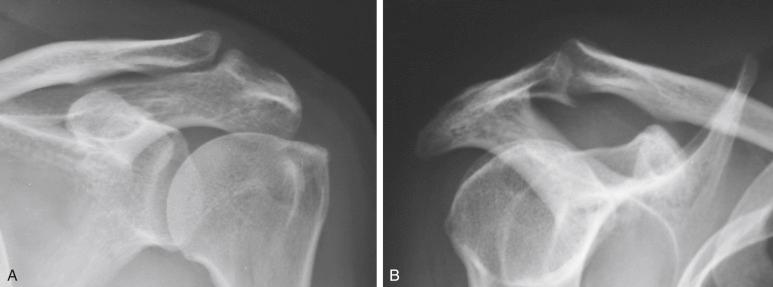
Hooked acromion on outlet view X-ray ( Fig. 7.1B )
Decreased coracohumeral distance (CHD) (shortest distance between the humeral head and the coracoid process) on the axial sequences of computed tomography (CT) or magnetic resonance imaging (MRI) scans of patients with subcoracoid impingement syndrome ( Fig. 7.2 )
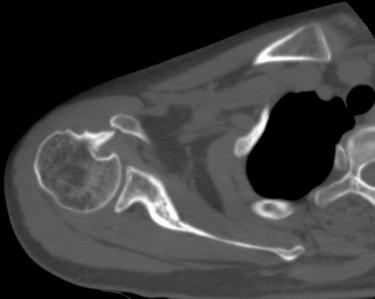
Internal impingement
Superior labral lesion on magnetic resonance arthrography (MRA) ( Fig. 7.3 )
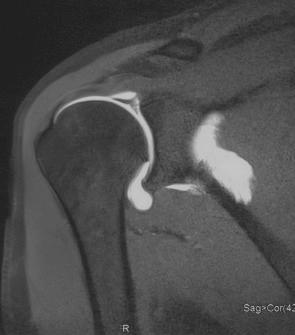
Posterosuperior labral lesions and articular-sided rotator cuff tears on MRI scans ( Fig. 7.4 )
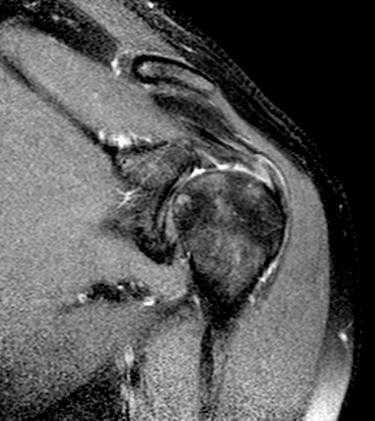
Outlet impingement
Nonoperative treatment
Rest
Nonsteroidal antiinflammatory medications
Corticosteroid injections
Activity modifications with avoidance of provocative positions
Physical therapy including rotator cuff and scapula-stabilizing musculature strengthening
Operative treatment
Arthroscopic subacromial (acromioplasty) or subcoracoid decompression (coracoplasty)
Internal impingement
Nonoperative treatment
Rest
Cryotherapy
Nonsteroidal antiinflammatory medications
Physical therapy including posterior capsular stretching and periscapular muscle strengthening for patients with decreased internal rotation capacity
Operative treatment
Debridement or repair of partial-thickness articular-sided rotator cuff tears
Debridement or repair of posterosuperior labral lesions
Inside the subacromial space
Acromion
Coracoid process ( Fig. 7.5A )
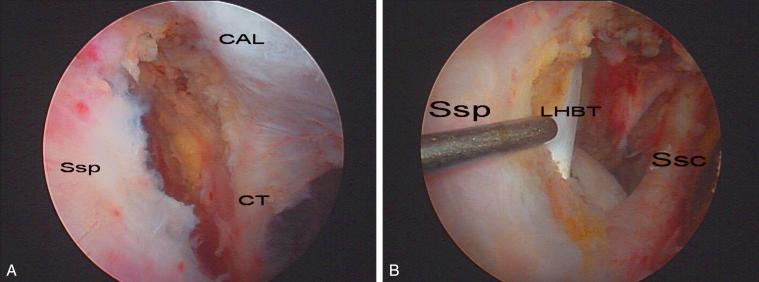
Coracoacromial ligament ( Fig. 7.5A )
Conjoined tendon ( Fig. 7.5A )
Long head of biceps tendon
Bursal side of the supraspinatus tendon
Upper portion of subscapularis
Inside the glenohumeral joint
Posterosuperior labrum
Articular side of the rotator cuff tendon ( Figs. 7.5A,B and 7.6A,B )
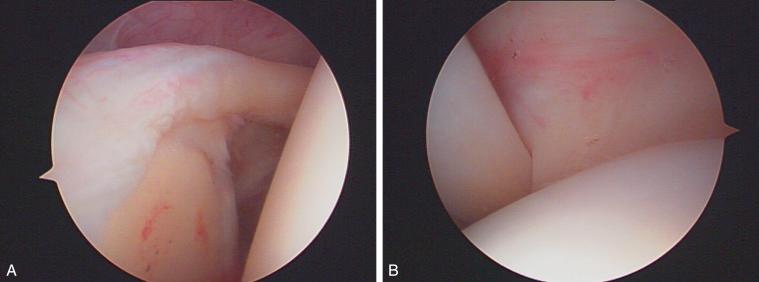
Outlet impingement.
Patients with persistent pain affecting the activities of daily living and symptoms irresponsive to conservative treatment (including subacromial cortisone injection and physiotherapy) for 3 to 6 months.
Acromioplasty is indicated for patients with hooked acromion or huge acromial spur with a healthy cuff or reparable rotator cuff tear.
Coracoplasty is indicated for the patients with both clinical and radiologic evidences of coracoid impingement (coracoid spur or close contact between coracoid and subscapularis).
Internal impingement.
Failure to respond to conservative treatment for 3 to 6 months (including intraarticular cortisone injection and physiotherapy).
Inability to return to sports despite at least 3 months of structured rehabilitation.
Simple debridement is needed for partial-thickness rotator cuff tears that involve less than 50% of the tendon thickness.
Rotator cuff repair is indicated for tears that affect more than 50% of the tendon thickness.
For young overhead athletes, debridement of posterosuperior labrum is indicated for type I and III superior labrum anterior and posterior (SLAP) lesions and SLAP repair in type II and IV SLAP lesions. Biceps tenodesis is recommended for older populations.
Superior-posterior labral repair in overhead athletes should be cautiously indicated in high-demand overhead athletes, e.g., baseball pitchers. Return to preinjury sports level is unpredicted in this group of patients.
Become a Clinical Tree membership for Full access and enjoy Unlimited articles
If you are a member. Log in here